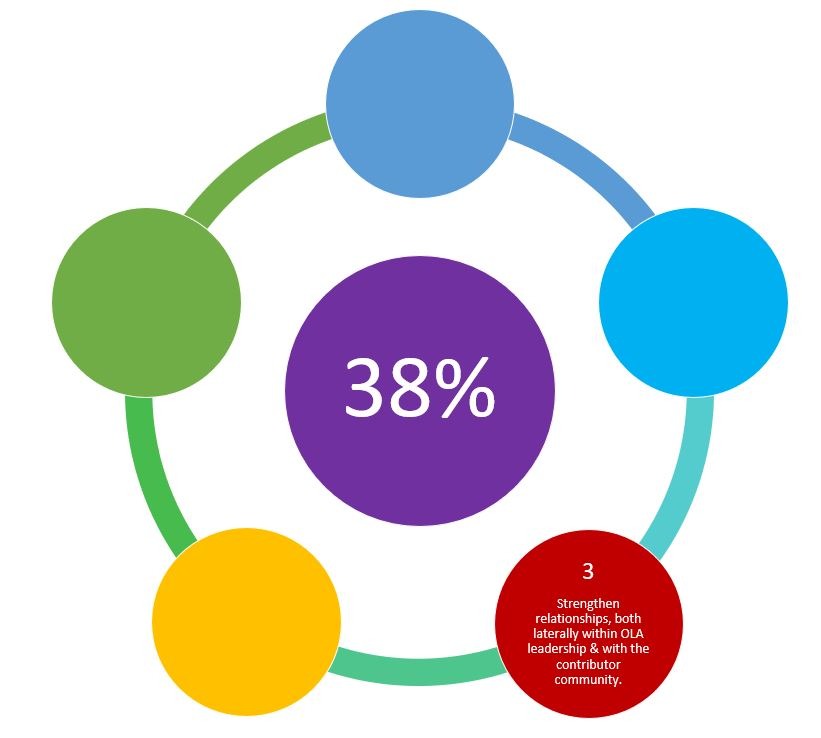Learn about the benefits of constructing a multi-year internship from a MLIS student's perspective.

Best laid plans: Quarterly update on the Open Shelf strategic plan
But Mousie, thou art no thy-lane,
In proving foresight may be vain:
The best laid schemes o’ Mice an’ Men
Gang aft agley,
An’ lea’e us nought but grief an’ pain,
For promis’d joy!
~ Robert Burns, To a Mouse
While Robert Burns laments plans gone wrong, we can celebrate a plan gone right. In late 2019, the Open Shelf editorial board finalized its first-ever strategic plan and, overall, the results in this first year are promising. The editorial team has made progress in 2020, despite working through a pandemic and the inevitable ebbs and flows in volunteer availability that have shifted some of our priorities and delayed or changed others. And now is a good time to report out to OLA members on the work that has been done . . . on the “front page” and behind the scenes.
The planning process
In developing the Open Shelf 2019— 2022 strategic plan, the editorial board began with the OLA strategic plan. The OLA 2017—2020 plan features a commitment to five key goals:
- Focusing member services across diverse career paths
- Influencing policy and demonstrating value
- Building evaluation and research capacity
- Addressing the unique needs of rural, and remote indigenous communities
- Enablers: People, technology, and fundraising
These goals provided a clearly articulated framework within which to develop strategic goals for the publication. As mentioned in the editor-in-chief’s March 2019 column, an engaged group of volunteers (including OLA Board liaisons Erika Heesen and Hélène Carrier) contributed to the conversation and the final product. The Open Shelf 2019 — 2022 strategic plan is posted on the magazine website, along with the first quarterly report.
Detailed progress update
The Year 1 (Q4) update broadly demonstrates the progress made towards achieving the strategic goals, and identifies where work still remains to be done. Here is a more detailed explanation of the completed and on-going work in each of the five priority areas identified in the strategic plan.
Priority 1: Expand the relevance of Open Shelf by telling more stories outside the perspective of experienced leaders in traditional libraries.

Over the past year, the magazine has featured a rich array of stories from individuals who are not “experienced leaders in traditional libraries” as well as articles from OLA members who might not have contributed substantively to the magazine to date.
- Rhea Smith has been a regular contributor through her on-going series Wildcard* Starting my library career! She has written seven articles, covering topics that range from food security to printing as an essential pandemic service, all while also engaging in the process of looking for her first position as a librarian.
- Samantha Martin-Bird was the Indigenous Relationships Supervisor for the Thunder Bay Public Library until June 2020.’s Her podcast Nish in the Library featured interviews with Indigenous writers, activists, artists, and librarians from across Canada.
- Two feature articles highlighted the work done by Margaret Tarpley and Kimberley Aslin. Margaret is now an adjunct lecturer in surgery at Vanderbilt University and helps to prepare medical students to work abroad. Kimberley is the librarian in a regional health centre.
- The magazine hosted its first-ever synchronous panel discussion last spring that featured twelve early, mid, and late library professionals, who engaged in a debate about the need for a master’s degree.
- Des articles entièrement rédigés en français sont maintenant publiés chaque année et l’équipe comprend désormais une éditrice de langue française.
Finally, a call for expressions of interest in writing collaborations will now be posted in the magazine several times per year (the first ad appears in this month’s issue).
Priority 2: Improve the geographic diversity of Open Shelf with more stories from rural, remote and Indigenous libraries.
 In 2020, members of the Open Shelf team have been able to to connect with individual members and committees and thus feature more stories from northern and eastern Ontario as well continue to publish columns such as Bessie Sullivan’s column Trees and Forests. Liaison officers are now in place with most divisions and these volunteers facilitate contributions from and support for writers.
In 2020, members of the Open Shelf team have been able to to connect with individual members and committees and thus feature more stories from northern and eastern Ontario as well continue to publish columns such as Bessie Sullivan’s column Trees and Forests. Liaison officers are now in place with most divisions and these volunteers facilitate contributions from and support for writers.
In addition, editorial team members will meet with library professionals working in northern Ontario (e.g., Temiskaming Shores) as well as at the Southern Ontario Library Service (SOLS) in January 2021 to begin the process of understanding barriers and incentives.
Priority 3: Strengthen relationships, both laterally within OLA leadership and with the contributor community.
 The editorial team is building a good working relationship with OLA’s advocacy and research officer, which has resulted in two stories in the magazine in the past year.
The editorial team is building a good working relationship with OLA’s advocacy and research officer, which has resulted in two stories in the magazine in the past year.
In addition, the editor-in-chief now reports quarterly to the OLA Board and attends at least one meeting a year in person or remotely. The Board appointed two of its members to act as liaisons to work with the editor-in-chief on an as-needed basis and these roles not only strengthen relationships between the editorial team and the Board, but also facilitate contributions to the magazine from Board members (e.g., last month’s article on the drive-thru Hallowe’en at the Blue Mountains Public Library and this month’s article on good-bad cinema (an interesting pandemic “silver lining”).
Other projects are underway. The team has started to:
- engage OLITA members in conversation about a guest editorship;
- draft a proposal for volunteer recognition and submit this proposal to the OLA Board for input;
- write the terms of reference for a new story committee and steering committee;
- revise this priority to include actions and metrics for the social media team; this team is developing its strategy for engaging and promoting contributors and stories and will develop own strategic plan for increasing visibility of magazine with OLA members and others working in the library sector in Ontario.
Priority 4: Expand strategic planning and assessment strategies to respond to reader expectations and demonstrate value.

The team has created and actioned its strategic plan. However, work on readership and engagement metrics is on-going, including the interpretation and actioning of data that is gathered from a number of sources, such as Google Analytics, monthly poll results, comments posted to individual articles, responses to calls for volunteers, and new story ideas.
Priority 5: Develop a sustainable, diverse editorial team with resources appropriate to the work of publishing Open Shelf.
 Inevitably, there has been volunteer turnover over the past year and the team has been able to promptly fill all posted positions including digital copy editor, digital editor, and story editor. Plus, the team now includes a French language editor. The editor-in-chief collaborates on an on-going basis for OLA staff to set the annual budget and OLA staff have supported several new expenditures, including subscriptions to the Canadian Press Style Guide and Soundcloud.
Inevitably, there has been volunteer turnover over the past year and the team has been able to promptly fill all posted positions including digital copy editor, digital editor, and story editor. Plus, the team now includes a French language editor. The editor-in-chief collaborates on an on-going basis for OLA staff to set the annual budget and OLA staff have supported several new expenditures, including subscriptions to the Canadian Press Style Guide and Soundcloud.
The team will continue to develop data visualizations and streamline publishing process, now that the team is at full complement. In addition, the new metadata team has completed a review and revisions of our tags and categories. This work has already improved the discoverability of articles and contributors.
Finally, this priority has been revised plan to include an on-going collaboration between the metadata team and social media teams to generate social media content and feature articles on the site in new ways.
On-going evaluation and reporting
The new senior editors will undoubtedly continue process of revising and reporting out on the plan and quarterly updates will be published on the Open Shelf home page (top navigation, under the heading About Open Shelf). While the “best laid schemes o’ mice and (wo)men’ can go awry”, this new decision-making framework is proving to be fruitful. The plan allows the team to strengthen its capacity for community engagement, and bringing members of the OLA community into relationship with one another is the main driver or purpose of the magazine.
Martha Attridge Bufton (MA, MLIS, Graduate Certificate in TBDL) is the Open Shelf editor-in-chief and a member of Editors Canada. Martha is the Interdisciplinary Studies Librarian in Research Support Services at the Carleton University Library and her research interests include game-based learning and culturally responsive pedagogy. She can be reached at martha.attridgebufton [at] carleton.ca.


